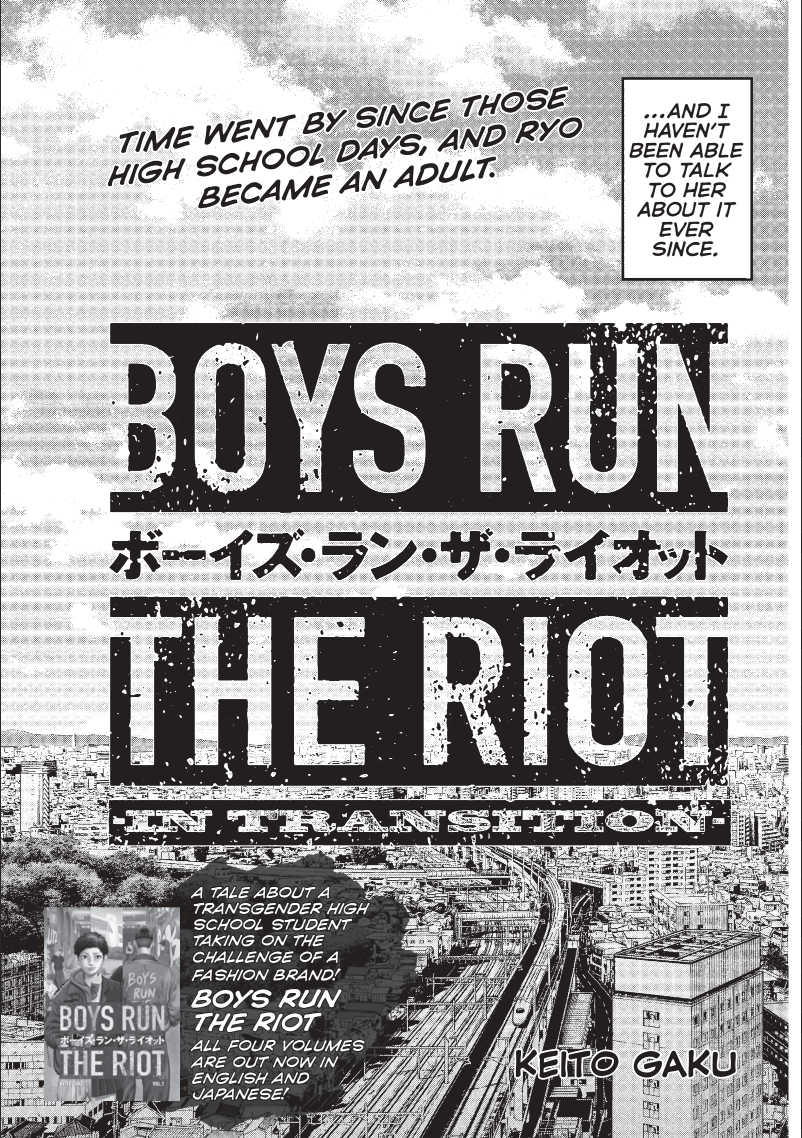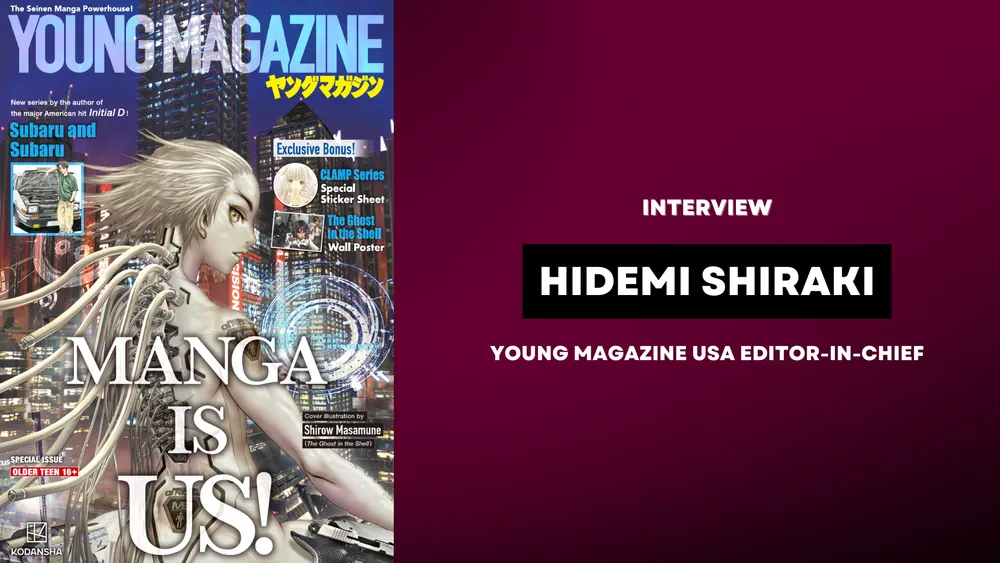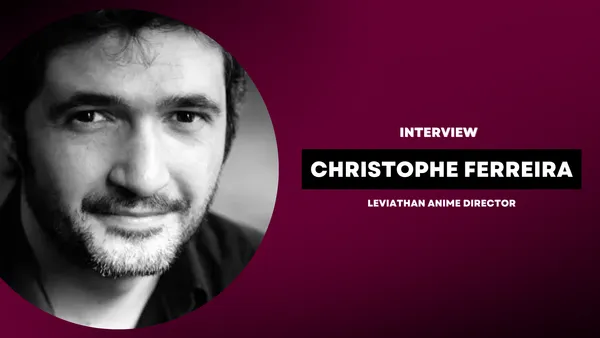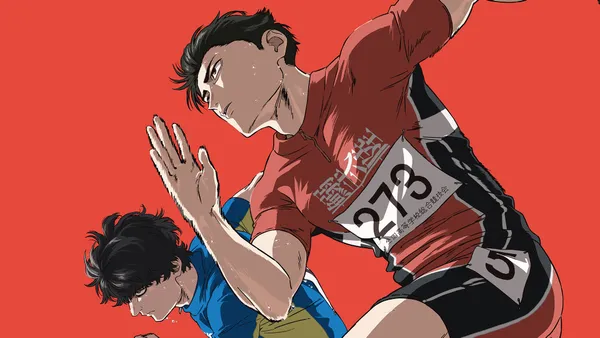Interview: Hidemi Shiraki, Editor-in-Chief of Young Magazine USA
Kodansha is bringing the Young Magazine to the USA this summer with a special 1,000+ page edition, featuring 20 titles, and information on the contest for new titles that will be serialized on the K MANGA app. To discuss this, we chatted with Hidemi Shiraki, the Editor-in-Chief of Young Magazine USA.
Shiraki has been with the Weekly Young Magazine for over a decade, and has worked on titles such as The Witch and the Beast and Starving Anonymous. He is also in charge of the special North American edition and, as such, was a perfect choice to answer our questions.
Q: What led to the decision to bring Young Magazine to the US?
Shiraki: As the North American manga market matured, we felt strongly that there was a need for a "next stage" following the shonen manga market. With the growing popularity of manga around the world, we were convinced that now was the right time to deliver seinen manga, highlighting the core of manga's diversity.
Q: Why the Young Magazine, as opposed to one of the other seinen magazines Kodansha publishes in Japan?
Shiraki: Young Magazine has always been the publication where we’ve stayed true to the most unfiltered, honest emotions. It features many works that confront fundamental human impulses—violence, sex, anger, and discomfort with society—head-on. We believed that this raw emotional intensity would resonate with today’s American readers. That’s why we chose the tagline “UN-filtered MANGA” as the magazine’s theme.
Additionally, as the magazine that gave birth to iconic works like AKIRA and Ghost in the Shell, we harbored the ambition to create the “next AKIRA.” The timing of the 45th anniversary of the magazine’s founding aligned perfectly with this vision. We also felt it was the ideal occasion to assemble a lineup that pushes boundaries more aggressively than other magazines.
Q: You did an open call for submissions that led to over 100 manga creators applying to have their work in this special edition of the Young Magazine. Can you tell us a little bit more about the process? Were you looking for something specific, or did you want to also give a chance to newcomers in the industry?
Shiraki: For this open call, we focused the selection criteria primarily on four genres that tend to resonate well in the North American market: sci-fi, dark fantasy, horror, and identity-themed works. However, rather than sticking rigidly to specific themes or styles, our goal was to broadly invite expressions that hold the potential to further expand the scope of seinen manga.
Above all, we placed great importance on giving opportunities to new creators. In fact, many of the published works come from newcomers. This reflects our belief that it is always the fresh voices of new artists who pave the way for a new era. We felt that the sharp, raw, and yet deeply earnest perspectives—unconstrained by existing norms—are precisely where the current age’s sense of reality truly resides.
Q: There are a lot of notable creators, well-known in the West too, who are involved in this special issue, such as Keito Gaku of BOYS RUN THE RIOT and Shuzo Oshimi of Flowers of Evil. Was that something you were actively hoping for, or was it just a coincidence that it lined up like this?
Shiraki: We reached out to established creators like Keito Gaku and Shuzo Oshimi, who have already gained popularity in North America, to contribute to the publication. While the special issue primarily focuses on new artists, we also wanted manga fans in North America to enjoy new works from well-known creators. We believe these talented artists are uniquely capable of tackling deeply personal and profound themes such as sexuality and inner darkness. Their work fits perfectly with Young Magazine USA’s concept of “bare your innermost self.”

Q: You talk about how seinen can explore beyond the themes of shonen titles. What kind of stories do you think this demographic (seinen) has more potential to depict?
Shiraki: Stories that explore the gray areas of human nature and the struggles of living within society are a unique strength of seinen manga. Whether it’s about love, work, crime, or sci-fi, everything is portrayed from the perspective of people living in the real world.
For example, in this issue, we have works like Pregnant, which delves into themes of gender and the nature of life, and Protocol Ryugu, which, while set in space, challenges readers with philosophical questions. Many of the stories gathered here cross genre boundaries and contain thought-provoking “questions” at their core.


Pregnant ©Denchi Matsumoto・Keita Nishijima/Kodansha Ltd.; Protocol Ryugu ©Daisaku Tsuru/Kodansha Ltd.
Q: Do you think the Western audience is more aware of demographics now than in the past?
Shiraki: There’s no doubt that understanding is deepening. The image of “manga = boys’ adventure stories” is quickly becoming a thing of the past. Especially with the rise of digital distribution and social media, a wide variety of manga styles have spread rapidly, and it’s clear that readers have become much more discerning as a result.
Q: Are Japanese publishers moving away from categorization based on demographics?
Shiraki: While categorizing by target readership still has its place, it’s true that we’re becoming less bound by those labels. Especially now, with more people reading through websites and apps, readers tend to choose works based more on themes or characters they resonate with, rather than strict genre classifications.
As editorial teams, we’re also shifting away from rigidly labeling something as “for boys” or “for adults,” and instead focusing on how to create stories that can earn support from a broader audience.
Q: Would you say that the appetite for more mature titles like seinen has grown in the West? Shonen has always been a staple, but as that audience ages, are you seeing a trend of them moving towards more seinen titles?
Shiraki: There’s no doubt that demand is growing. The generation that grew up reading shonen manga continues to read manga well into adulthood. What those readers are now looking for are stories that feel connected to their own lives—in other words, seinen manga.
In fact, access to works that include social themes such as violence, sex, and discomfort with the times is also growing overseas, and the "Seinen" genre itself is clearly gaining in presence.
Q: When titles are chosen for serialization in the Japanese Weekly Young Magazine, are the editorial team considering what would appeal to a Western audience down the road as well, or are titles still chosen purely based on how they’re expected to perform in Japan?
Shiraki: Fundamentally, we prioritize the response from readers in Japan. After all, if a series doesn’t gain popularity domestically, it risks being canceled.
That said, in recent years we’ve definitely become more conscious of how a work might resonate with overseas readers. This is not so much for the sake of "buzz" but rather to determine the potential for the themes and characters of our works to reach readers in other countries and cultures. We believe that Young Magazine USA is an extension of this trend.
Q: The K MANGA contest will have readers choosing their favorite title for serialization. Can you tell us a bit about how the 16 candidates were chosen?
Shiraki: First of all, the K MANGA contest and Young Magazine USA are completely separate projects. The only connection is that the works selected through Young Magazine USA’s reader voting will go on to be serialized on K MANGA.
Narrowing the selection down to 16 titles wasn’t easy. In the end, what we focused on most was whether the work was created with honesty, whether it confronted something meaningful, and whether it told a story that feels necessary in today’s world. While we did consider compatibility with the North American market and mainly focused on sci-fi, dark fantasy, horror, and identity-driven genres, more than anything, we prioritized whether each piece had a strong core at its heart.
Q: When it comes to simulpubs, how do you choose which titles get serialized like that? Popularity in Japan, expected popularity overseas, or some other factor?
Shiraki: If you’re referring to simulpub releases on K MANGA, the main criteria are usually whether the title is a hit in Japan and whether it has the potential to succeed overseas. Anime adaptations are also a major advantage when it comes to reaching international readers. While domestic popularity in Japan is certainly a factor, we also place strong emphasis on whether the story will come across clearly in translation and whether it won’t be misinterpreted in a different cultural context.
We carefully consider the nuance of dialogue, the cultural background, and the emotional impact after reading. The decision is made through discussions within the team, weighing all of these factors to ensure the work will genuinely connect with readers abroad.
Q: If this special edition of Young Magazine performs well, are there plans to continue with subsequent issues, or was the intention always to publish it as a one-off?
Shiraki: This issue will be treated as a one-time commemorative issue, but in the future, we would like to make it a regular publication with a view to selling it in bookstores. In addition to publication as a magazine, we are also considering a wide range of other developments via the web and apps.
Q: This issue is being distributed as part of Anime NYC and through participating Kinokuniya locations, but are there any plans to release it in Europe as well? Either through a convention or some other form of distribution?
Shiraki: Yes, we are definitely looking at expanding into the European market in the future. Europe is an extremely important region for us. Depending on the response to Young Magazine USA, we would love to take on a similar challenge in various European countries as well.
Since each country differs in terms of what kinds of stories resonate, what can be expressed, and what regulations apply at the point of sale, we're starting by focusing on market research to better understand those specifics.
Young Magazine USA will be distributed for free to attendees of Anime NYC (August 21-24) at the Kinokuniya booth. The magazine will also be available at 17 Kunikoniya locations in the US from August 21 to November 10, 2025.
Voting for the best title that will win the K MANGA app serialization also launches on August 21 and will last until November 10. Winners will be announced on December 15, 2025. The website for voting launches on August 21, and all information will be announced on the official X/Twitter account for Young Magazine USA.
©︎ 2025 KODANSHA LTD. ALL RIGHTS RESERVED.




